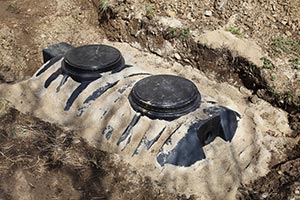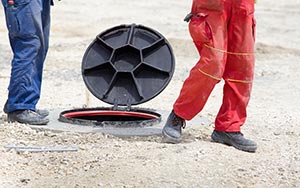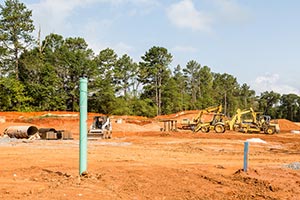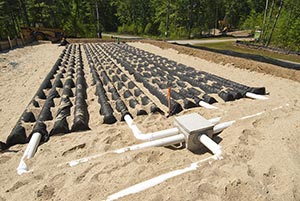Please see below for more information and forms required surrounding municipal or city sewage systems, and subdivision of land.
Learn about the requirements for sewage disposal systems
Any home or building that is not connected to a municipal or city sewage system needs a method for getting rid of human waste. Some buildings, usually in rural settings with no running water, may use an outhouse or privy.

Requirements for sewage disposal systems:
All buildings with indoor plumbing need to have a sewage disposal system that is in compliance with the Sewerage System Regulation.
Every owner who wants to construct a new septic system, or alter or repair an existing one, must retain the services of an authorized person who may be a professional engineer or a registered onsite waste water practitioner to design and oversee construction of the disposal system.
When it is not possible to install a sewerage system on a parcel of land, the owner may choose to install a sewage holding tank that meets the Sewerage System Regulation requirements. More information can be found in the Holding Tank section below.
Filing a record of sewerage system or a letter of certification:
Record of sewerage system
Before the construction, alteration, or repair of a sewerage system, an Authorized Person must submit information respecting the designed details of the system on a Record of Sewerage System form (Fillable PDF). A fee (see below) is required when submitting a Record of Sewage System.
Letter of certification
Within 30 days of completing construction of the sewerage system, the Authorized Person must submit to the Health Authority a signed letter certifying that system meets the requirements of the Sewerage System Regulation. This is to be completed on a Letter of Certification form (Fillable PDF).
How do I submit the filing, forms, and additional file attachments?
- Process for submitting Record of Sewerage and Letter of Certification.
- Download the appropriate forms (Record of Sewerage and Letter of Certification) in links above.
- Fill out "pdf-fillable" forms and save copy to your computer.
- Print copy of the completed forms.
- Assemble documents for submitting to Northern Health:
- Filing (include completed Record of Sewerage form and any additional required information for the filing)
- Letter of Certification
- Drop off documents to any Public Health Protection Office.
If your browser doesn't display the fillable PDF correctly, or some functions do not work please save the PDF to your desktop and open it in Adobe Acrobat Reader.
Learn about installing a sewage holding tank
When it is not possible to install a sewerage system on a parcel of land, the owner may choose to install a sewage holding tank that meets the Sewerage System Regulation requirements.

Information on requirements for the permitting of holding tanks can be found in:
- Sewerage holding tanks (PDF) - General information on holding tanks and application process.
- Holding tank planning and installation guidelines (PDF)
To apply for a holding tank, please use the following application form (Fillable PDF). Fees (see below) for submitting a holding tank application.
Once the installation of a holding tank has been completed, the applicant must submit a record of installation (Fillable PDF), and all supporting documents to the local Environmental Health Officer. A holding tank must not be used until this form has been accepted by the Health Authority.
For any questions, please contact your local Environmental Health Officer to discuss.
If your browser doesn't display the fillable PDF correctly, or some functions do not work please save the PDF to your desktop and open it in Adobe Acrobat Reader.
Learn about Northern Health's role in the subdivision process and our guidelines

Northern Health plays a consulting role in the subdivision process. We provide comments for Ministry of Transportation and Transit or local government Approving Officers to consider whether or not a subdivision application should be approved.
In rural settings, we are interested in ensuring newly created parcels have appropriate site conditions so that onsite sewerage does not contaminate water and will not cause a health hazard, both in the present and future.
When subdivision applications are referred to Northern Health, an Environmental Health Officer will assess their application and provide comments to the Approving Officer regarding the land parcels' suitability in supporting onsite sewerage disposal. Each proposed lot is evaluated to determine whether there are at least two areas of land suitable for onsite sewerage disposal.
A site assessment report must be included with the application submitted to the approving agency in order for an Environmental Health Officer to review and provide comments on. The site assessment and report must be completed by an Authorized Person.
The report must include the information described in the subdivision application checklist (PDF). More information on the subdivision processes can be found in the subdivision guidelines (PDF).
Find out how to search for a sewerage system filing on a property
A search can be done for a property by contacting your local Health Protection Office.
A non-refundable fee of $50 is required with a completed sewerage file information request form (Fillable PDF).
Please note that we cannot guarantee that a file will be located or that it will include an accurate diagram of the system. If no information is available, either the original paperwork is very old, or could not be filed due to incorrect information, or the sewage system was constructed/repaired without proper authorization.
If your browser doesn't display the fillable PDF correctly, or some functions do not work please save the PDF to your desktop and open it in Adobe Acrobat Reader.
Find out about fees related to land use and onsite sewage
Item: | Cost: |
|---|---|
Filing fee for Record of Sewerage | $200 |
Holding Tank Permit | $400 |
Filing/Permit Search for Sewerage System | $50 |
Who is an Authorized Person (AP)?
An Authorized Person (AP) is either a Professional or a Registered Onsite Wastewater Practitioner (ROWP). Both Professionals and ROWPs have training and experience in designing and installing sewerage systems.
What is a professional and what kinds of systems can they construct?
A professional is someone who has professional status and is competent in the area of sewerage system design. Professionals are typically engineers or geoscientists. The BC Association of Professional Engineers and Geoscientists maintains a list of professionals who do sewerage system work. A professional can design and install type 1, 2 and 3 systems with a daily design flow up to 22,699 liters per day.
What is a ROWP and what kinds of systems can they construct?
A ROWP is a Registered Onsite Wastewater Practitioner. The Applied Science Technologists and Technicians Association of BC issues ROWP’s their registration status. ROWP’s can design and install Type 1 and 2 systems which have a daily design flow less than 9100 liters per day. ROWP’s can be registered in up to five different categories. They can be planners, installers, maintenance providers, private inspectors (commercial) or private inspectors (residential). It should be noted that many ROWPS are registered in more than one category. For more information on ROWP’s go to ASTTBC.
How do I find a ROWP?
To find a ROWP go to ASTTBC.
How do I find a professional?
To find a professional go to APEGBC. It should be noted that this website only lists those professional who have listed their sewerage services with APEGBC. There may be other professionals that provide sewerage system services. To find those you could contact a ROWP or use the local yellow pages to search engineering firms.
Why maintain my sewage system?
Not maintaining a sewerage system is one of the leading causes of premature system failure. Repairs to systems are often much more expensive than the maintenance of the existing system. Repairs to failed systems often involve the need to construction brand new systems. Sewage system failures, with sewage ponding on the ground surface are considered health hazards and can pose a threat to the environment or drinking water supplies. The owner is required by law to remedy a failing system as soon as possible. Owners of sewerage systems constructed under the Sewerage System Regulations should have a maintenance plan provided by the AP at the time the system was constructed. Owners of these systems should adhere to that maintenance plan. Owners of older systems will not have a maintenance plan but could obtain the services of an AP maintenance provider to develop a maintenance plan for them.
How do I repair my sewage system?
Your first step should be to contact an AP. If sewage is ponding on the ground surface or entering a drinking water supply you should be reporting it to an Environmental Health Officer. You are not permitted to repair your system unless supervised by an AP.
What are the design criteria for constructing sewerage systems?
All AP’s are required to construct sewerage systems in accordance with standard practice. The BC Ministry of Health maintains the BC Standard Practice Manual which is but one standard practice. The BC SPM can be found at BC MOH. It should be noted that ASTTBC expects ROWP’s to follow this manual. Professionals can choose to use this design manual or they can choose another manual but if they use another standard it still must be a one that would be considered standard practice.
As a homeowner can I build my own sewerage system?
Yes, as a homeowner you can build your own sewerage system but an AP must still design the system, submit Filing documents to the Health Authority and supervise the systems construction.
What information does the AP need to submit to the Health Authority before construction of the system can begin?
Prior to constructing a sewerage system an AP must “File” information with the Health Authority. This information submission includes a Filing form, plans and specification of the sewerage system, a property site plan, any applicable covenants, easements or hydrogeological reports. The Filing form includes information about the owner, AP, property location, site conditions, type of sewerage system being constructed and the type of structure the system will be serving.
What information is required in the Letter of Certification and when can I use my new sewage system?
The letter of Certification (LOC) is a document signed by the AP saying that; the AP has lawfully constructed the sewerage system, construction of the sewerage system is completed, the system if used as intended will not cause or contribute to a health hazard and that the daily design flow is less than 22,700 liters per day. It also includes an as-built diagram of the sewerage system and a maintenance plan prepared by the AP. It is a legal requirement that the LOC be submitted within 30 days of completing construction. The sewerage system cannot be put into use until the LOC is submitted to the Health Authority.
Do I need to hire an AP for minor repairs to my sewerage system?
Yes, all repairs and maintenance to sewerage systems must be performed by authorized persons or under the supervision of an authorized person.
I’m changing the use of my building and am not sure if I have to upgrade the sewerage system?
If there is a potential increase in the daily sewage flow you likely have to update the sewerage system. The Sewerage System Regulation requires the owner of a building to ensure the sewerage system is designed to accommodate sewage from that building. The need to upgrade the sewerage systems can result from change of building size (increased square footage or increase in number of bedrooms), change in sewage flow (adding more seats to a restaurant) or changing sewage strength (corner store changing to a restaurant). If the change to the building requires a building permit the Building Inspection Authority may require you to obtain a report from an AP to assess the system’s capacity to accommodate the building changes. If you are making changing to a commercial establishment such as a restaurant the local Environmental Health Officer may require you to obtain a report from an AP to assess the system’s capacity to accommodate the building changes. If you are in doubt you can contact an AP or contact an Environmental Health Officer.
I’m looking to purchase a home with a sewerage system what should I look for?
You should first contact an AP to do an inspection and provide you with a report on the status of the existing sewerage system. Secondly, you should tell the AP exactly what your plans are for the property i.e. number of people who will live in the house, future plans for expanding the building or any planned in-home small businesses. It is unlikely that any sewerage system will last forever and that an AP will predict the useful life expectancy of the existing sewerage system so you could ask the AP to identify a suitable replacement area for a new sewerage system. With respect to any upgrades or replacements of existing systems you could obtain a quote for those costs as new sewerage systems or repairs to existing systems can be expensive.
You can check Health Authority records to compare file records to what is installed. You can require the current owner to provide you with a declaration of all work, including maintenance, done on the system.
Does the health authority approve the AP’s sewerage system design and filing documents?
No, the Health Authority does not approve the sewerage system design nor does the Health Authority routinely review Filing documents for their technical merit. The Health Authority’s role is to receive Filing documents from APs and to ensure those documents meet the minimum submission criteria i.e. did the AP correctly complete the Filing form, provide plans and specification and provide a site plan drawn to scale. It is the full responsibility of the AP to ensure the sewerage system design meets standard practice and to ensure that the system is suitable for its intended purpose.
How do I make a complaint about an AP?
For health based complaints respecting malfunctioning sewerage systems you can contact the Health Authority Environmental Health Officer. For complaints regarding professional practice you can contact the AP’s professional association.
How do I make a complaint about my neighbor’s failing sewage system or of a system being constructed illegally?
For either of these situations you can contact an Environmental Health Officer. Be prepared to provide the Environmental Health Officer with specifics such as the property address. It is an offence to construct or repair a sewerage system without proper qualification, without first submitting Filing documents, to discharge sewage onto the ground surface, into a body of water or into a source of drinking water.
How do I find my septic tank?
You can follow instructions provided by the Water Stewardship Information Series (PDF). There are safety protocols to follow with opening a septic tank. Ensure the entire document is reviewed before attempting to open a septic tank.
What happens when a septic system fails?
A failing sewage system typically results in sewage ponding on the ground surface. The receiving environment (subsurface soil) is saturated and/or the soil pores are clogged. This can be the result of a number of things such as; the system has not been maintained properly, the system has been overused, the system is coming to the end of its useful life expectancy, the system was too small for the amount of sewage it received, the system was designed or installed improperly. It can even be a failure to one of the systems components such as a broken effluent pump in a pump chamber. In any case it is the responsibility of the owner to repair the system as soon as possible.
How can I tell if my septic system is failing?
Initially, failures can begin with slowly draining fixtures such as sinks, showers and tubs. It is likely that the receiving environment (soil) can no longer accept the sewage. The soil is clogged from the sewage particles and can no longer drain fast enough to receive new effluent. Prolonged failures are evident by sewage ponding on the ground surface. The ponding effluent will be quite odorous with a grey color. Flushing non toxic dyes down the toilet will confirm that the ponding liquid is sewage. Keep pets and people away from the ponding sewage and contact an AP to have the system repaired as soon as possible.
If you have a health and safety concern or complaint about an onsite sewage issue, please contact an Environmental Health Officer.

